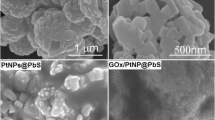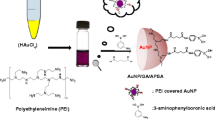Abstract
Previous work has shown that glucose oxidase can be immobilized on platinum to give an electrode that responds potentiometrically to glucose over the clinically useful range of about 10–250 mg glucose/100 mL. The present studies were carried out with electrochemically pretreated platinum and with gold or porous graphite substituted for the platinum support. The presence of the enzyme gave a significantly enhanced potentiometric response over that obtained with the bare support for both the pretreated platinum and the porous graphite, but not with gold. However, with platinum the potentiometric response became more negative with increasing glucose concentration. With porous graphite, the potential changed in the positive direction as the glucose concentration was increased. Hysteresis was demonstrated for the platinum-enzyme electrode. Mass transfer measurements with a rotating ring-disc electrode (RRDE) showed measurable diffusional resistances to the transport of a model electroactive compound (potassium ferrocyanide) through a matrix of immobilized enzyme attached to the disc of the RRDE. These results are part of a larger study to define the source of the potentiometric response by examining the roles of the support and the mass transfer resistances through the immobilized enzyme matrix.
Similar content being viewed by others
References
Wingard Jr., L. B., Liu, C. C.,and Nagda, N. L. (1971),Biotechnol. Bioeng. 13, 629.
Layne, E. G., Schultz, R. D., Thomas Jr., L. J., Slama, G., Saylor, D. F., and Bessman, S. P. (1976),Diabetes 25, 81.
Updike, S. J., Shults, M., and Ekman, B. (1982),Diabetes Care 5, 207.
Liu, C. C., Wingard Jr., L. B., Wolfson Jr., S. K., Yao, S. J., Drash, A. L., and Schiller, J. G. (1979),Bioelectrochem. Bioenergetics 6, 19.
Wingard Jr., L. B., Schiller, J. G., Wolfson Jr., S. K., Liu, C. C., Drash, A. L., and Yao, S. J. (1979),J. Biomed. Mater. Res. 13, 921.
Wingard Jr., L. B., Ellis, D., Yao, S. J., Schiller, J. G., Liu, C. C., Wolfson Jr., S. K., and Drash, A. L. (1979),J. Solid Phase Biochem. 4, 253.
Angerstein-Kozlowska, H., Conway, B. E., and Sharp, W. B. A. (1973),Electroanal. Chem. Interfac. Electrochem. 43, 9.
Hoare, J. P. (1974) inEncyclopedia of Electrochemistry of the Elements, vol. 2, Bard, A. J., ed., Dekker, NY, pp. 191–353.
Elliott, C. M., and Murray, R. W. (1976),Anal. Chem. 48, 1247.
Lenhard, J. R., and Murray, R. W. (1978),J. Am. Chem. Soc. 100, 7870.
Author information
Authors and Affiliations
Rights and permissions
About this article
Cite this article
Wingard, L.B., Castner, J.F., Yao, S.J. et al. Immobilized Glucose Oxidase in the Potentiometric Detection of Glucose. Appl Biochem Biotechnol 9, 95–104 (1984). https://doi.org/10.1007/BF02798377
Received:
Accepted:
Issue Date:
DOI: https://doi.org/10.1007/BF02798377
Index Entries
- Glucose oxidase, immobilized
- immobilized glucose oxidase
- potentiometric determination of glucose
- rotating ring-disc electrode, in glucose detection
- glucose electrode
- platinum-enzyme electrode, in glucose determination
- en-zymes, immobilized on platinum
- chemically modified electrode
- diabetes, detection of glucose in
- gold-enzyme electrode
- graphite-enzyme electrode
- glucose determination, by immobilized enzyme electrode
- oxidase, immobilized glucose




